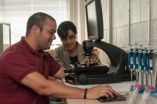(Press-News.org) Cold Spring Harbor, N.Y. – During embryonic development in humans and other mammals, sperm and egg cells are essentially wiped clean of chemical modifications to DNA called epigenetic marks. They are then held in reserve to await fertilization.
In flowering plants the scenario is dramatically different. Germ cells don't even appear until the post-embryonic period – sometimes not until many years later. When they do appear, only some epigenetic marks are wiped away; some remain, carried over from prior generations – although until now little was known about how or to what extent.
"What we did know," says Professor and HHMI-GBMF Investigator Rob Martienssen, Ph.D., of Cold Spring Harbor Laboratory (CSHL), "was that epigenetic inheritance – the inheritance by offspring of chemical "tags" present in parental DNA that modify the expression of genes – is much more widespread in plants than in animals."
In new research published online today in the journal Cell, Martienssen and colleagues show that genome reprogramming through these epigenetic mechanisms is guided by small RNAs and is passed on to the next generation.
Some DNA is tagged with epigenetic marks
It has long been known that in plants, as the male germline pollen grains develop, they give rise to two sperm cells, and a structure called the vegetative nucleus, also known as the "nurse cell" because it provides energy and nourishment to the sperm cells.
The DNA in germ cells can exist in two dramatically different states: in one, it is very densely packed and essentially inaccessible to the cellular machinery that enables individual genes to be "expressed." In the other, in which the packing is much looser, genes can be expressed. In the latter state, because the genetic material is accessible, it is can also be modified by various chemical groups (two common ones are methyl and acetyl) which tend to attach to the DNA at specific locations.
These chemical tags are called epigenetic marks. The attachment of, for instance, a methyl group to a particular stretch of DNA containing a gene tends to prevent that gene from being accessed by the gene-expression machinery, and thus prevents the gene from being expressed.
Inherited methylation patterns are guided by small RNAs
Probing further into the set of modifications on the DNA in plant pollen grains, Martienssen and colleagues decided to look at the particular set of chemical marks called methyl groups. When they separated out pollen grains in different stages of development they found distinct patterns of the attachment of methyl groups to DNA.
They also noticed the corresponding accumulation of small RNAs, including two classes of so-called short-interfering RNAs (siRNAs) – tiny RNA molecules, 21 or 24 nucleotides in length -- involved in silencing gene expression. These small siRNAs act as guides to where methylation will occur, silencing gene expression.
Previous work by the Martienssen lab and their collaborators, including a team of pollen specialists from the Instituto Gulbenkian de Ciencia in Lisbon, Portugal, has shown that these epigenetic mechanisms are important for keeping transposons in check. Also known as "jumping genes" for their ability to be expressed and then re-insert themselves at random into a different area of the genome, transposons are dangerous because they can cause damage to DNA and disrupt genetic function.
In the current study, Martienssen's team discovered that while in sperm, some areas of DNA containing transposons had "lost" methyl groups, and thus had the potential to be expressed, the same stretches of DNA were observed to be methylated in the seed embryo. This was associated with the accumulation of 21 nucleotide long siRNA in the mature pollen and 24 nucelotide long siRNA in the seed embryo. Martienssen speculates that the loss of methylation in the sperm and subsequent re-methylation during fertilization may reflect an ancient mechanism for transposon recognition and silencing.
A second important observation made by the team was of the loss of methylation in "nurse cells." Methylation at these same sites is retained in the associated sperm cells, and, too, is associated with accumulation of 24 nucleotide siRNA. This process results in areas of recurrent epigenetic marking that are pre-methylated in the germline sperm and carried on to the next generation.
"This is what, at least in part, enables plants to inherit acquired traits from prior generations – something that we mammals can rarely do," Martienssen observes.
Being able to trace the inheritance of traits – both wanted and unwanted -- in plants, and notably in agricultural crops, is important for farmers. Martienssen predicts that "defining inheritance through epigenetic modifications will influence the ways people think about cross-breeding to select for desired traits." Such traits as resistance to temperature variation in crops have important agricultural and economic implications.
###
"Reprogramming of DNA Methylation in Pollen Guides Epigenetic Inheritance via Small RNA" is published online in Cell on September 20, 2012. The authors are: Joseph P. Calarco, Filipe Borges, Mark T Donoghue, Frédéric Van Ex, Pauline E Jullien, Telma Lopes, Rui Gardner, Frédéric Berger, José A Feijó, Jörg D Becker, Robert A Martienssen. The paper can be obtained online at Cell press.
The research described in this release was supported by the following grants and funding agencies: NIH grant R01 GM067014 to R.A.M., grants PTDC/AGR-GPL/103778/2008 and PTDC/BIA-BCM/103787/2008 from Fundação para a Ciência e a Tecnologia (FCT) to J.D.B. and FCT grant PTDC/BIA-BCM/108044/2008 to J.A.F. F. Berger and P.E.J. were supported by Temasek Lifescience Laboratory. J.P.C. was supported by a graduate student fellowship from NSERC and by a grant from the Fred C. Gloeckner Foundation, F. Borges was supported by a FCT PhD fellowship SFRH/BD/48761/2008, and F.V.E. was funded by a Herbert Hoover postdoctoral fellowship from the Belgian American Educational Foundation.
About Cold Spring Harbor Laboratory
Founded in 1890, Cold Spring Harbor Laboratory (CSHL) has shaped contemporary biomedical research and education with programs in cancer, neuroscience, plant biology and quantitative biology. CSHL is ranked number one in the world by Thomson Reuters for impact of its research in molecular biology and genetics. The Laboratory has been home to eight Nobel Prize winners. Today, CSHL's multidisciplinary scientific community is more than 360 scientists strong and its Meetings & Courses program hosts more than 12,500 scientists from around the world each year to its Long Island campus and its China center. Tens of thousands more benefit from the research, reviews, and ideas published in journals and books distributed internationally by CSHL Press. The Laboratory's education arm also includes a graduate school and programs for undergraduates as well as middle and high school students and teachers. CSHL is a private, not-for-profit institution on the north shore of Long Island. For more information, visit www.cshl.edu.
Written by: Edward Brydon, Science Writer | ebrydon@cshl.edu | 516-367-6822
Scientists uncover mechanism by which plants inherit epigenetic modifications
Small RNAs guide epigenetic modifications of DNA that lead to genome reprogramming
2012-09-20
ELSE PRESS RELEASES FROM THIS DATE:
Nutrient in eggs and meat may influence gene expression from infancy to adulthood
2012-09-20
Just as women are advised to get plenty of folic acid around the time of conception and throughout early pregnancy, new research suggests another very similar nutrient may one day deserve a spot on the obstetrician's list of recommendations.
Consuming greater amounts of choline – a nutrient found in eggs and meat – during pregnancy may lower an infant's vulnerability to stress-related illnesses, such as mental health disturbances, and chronic conditions, like hypertension, later in life.
In an early study in The FASEB Journal, nutrition scientists and obstetricians ...
Data link project provides new insight about the US R&D activities of multinational companies
2012-09-20
Findings from the Research and Development Data Link Project showed that both parent companies of U.S. multinational companies and U.S. affiliates of foreign multinational companies devoted about three-fourths of their R&D expenditures to development activities in 2007.
This newly developed information is from the Research and Development Data Link Project--a joint project of the National Science Foundation, U.S. Census Bureau and Bureau of Economic Analysis.
In linking surveys from these three agencies, the Data Link Project provided more comprehensive information ...
Ergonomic Nursing Pillow with Innovative Features Benefits New Moms
2012-09-20
The Sweet Oasis nursing pillow, designed to help mothers nurse more comfortably, is now available via the web and in select baby boutiques throughout the Denver area.
Designed by a breastfeeding mom, the Sweet Oasis pillow makes nursing more comfortable for mother and baby by ergonomic and secure positioning every feeding. The Sweet Oasis nursing pillow's patent-pending design, intended for nursing or bottle-feeding on the caregiver's lap, aligns baby in a healthy, inclined position; provides greater stability and safety; and washes and carries easily.
Mother and ...
Genetic mutation may have allowed early humans to migrate throughout Africa, research says
2012-09-20
WINSTON-SALEM, N.C. – Sept. 19, 2012 – A genetic mutation that occurred thousands of years ago might be the answer to how early humans were able to move from central Africa and across the continent in what has been called "the great expansion," according to new research from Wake Forest Baptist Medical Center.
By analyzing genetic sequence variation patterns in different populations around the world, three teams of scientists from Wake Forest Baptist, Johns Hopkins University School of Medicine and the University of Washington School of Medicine, Seattle, demonstrated ...
Clemson psychology professor conducts sleep research at Vienna university
2012-09-20
CLEMSON — Clemson University psychology professor June Pilcher returned recently from Austria, where she worked with University of Vienna researchers to study ways college students' sleep habits affect how they function socially.
Pilcher received a Fulbright-Freud Award to work with the Social, Cognitive, Affective and Neuroscience Unit (SCAN) at the University of Vienna. She also worked with the Sigmund Freud Museum, giving a series of talks and lectures.
Pilcher participated in research with the university's SCAN unit, a center that conducts research in the fields ...
Satellite sees post-Tropical Cyclone Lane fizzle in a blanket of low clouds
2012-09-20
Former Hurricane Lane has fizzled and its remnant circulation was spotted in a blanket of low clouds in the Eastern Pacific Ocean.
NOAA's GOES-15 satellite sits in a fixed orbit over the western U.S. and captures continuous visible and infrared imagery of the western U.S. and the Eastern Pacific Ocean. On Sept. 19 at 11:45 a.m. EDT, GOES-15 captured a visible image of post-tropical Lane's remnants that appear as a small circulation center. The center was located over 1,000 miles from Baja California in an extensive field of stratocumulus clouds. Stratocumulus clouds are ...
Evolution is as complicated as 1-2-3
2012-09-20
EAST LANSING, Mich. — A team of researchers at Michigan State University has documented the step-by-step process in which organisms evolve new functions.
The results, published in the current issue of Nature, are revealed through an in-depth, genomics-based analysis that decodes how E. coli bacteria figured out how to supplement a traditional diet of glucose with an extra course of citrate.
"It's pretty nifty to see a new biological function evolve," said Zachary Blount, postdoctoral researcher in MSU's BEACON Center for the Study of Evolution in Action. "The first ...
Study shows how consumers shift expectations and goals
2012-09-20
NEW YORK - September 19, 2012 - Sally and Harry are about to invest in their company's 401(k) plan. Sally chooses the best performing mutual fund, which has high risks but boasts a 25 percent year-to-date return. Harry, after considering the tradeoffs between risks and rewards, opts for a lower performing fund with an 8 percent year-to-date return. When they receive their next quarterly performance reports, both Sally and Harry discover that their funds have met their initial expectations. Are they satisfied? If not, why? And how could their levels of satisfaction be improved?
One ...
Using a laser to 'see' the smallest world
2012-09-20
(Santa Barbara, Calif.) –– A multi-university team has employed a high-powered laser based at UC Santa Barbara to dramatically improve one of the tools scientists use to study the world at the atomic level. The team used their amped-up electron paramagnetic resonance (EPR) spectrometer to study the electron spin of free radicals and nitrogen atoms trapped inside a diamond.
The improvement will pull back the veil that shrouds the molecular world, allowing scientists to study tiny molecules at a high resolution.
The team, which includes researchers from UCSB, University ...
UGA researchers boost efficacy of drugs by using nanoparticles to target 'powerhouse of cells'
2012-09-20
Athens, Ga. - Nanoparticles have shown great promise in the targeted delivery of drugs to cells, but researchers at the University of Georgia have refined the drug delivery process further by using nanoparticles to deliver drugs to a specific organelle within cells.
By targeting mitochondria, often called "the powerhouse of cells," the researchers increased the effectiveness of mitochondria-acting therapeutics used to treat cancer, Alzheimer's disease and obesity in studies conducted with cultured cells.
"The mitochondrion is a complex organelle that is very difficult ...
LAST 30 PRESS RELEASES:
Signature patterns of brain activity may help predict recovery from traumatic brain injury
Dresden study uncovers new key mechanism in cancer cells
New species are now being discovered faster than ever before, study suggests
Cannabis-based products show limited short-term benefit for chronic pain, with increased risk of adverse effects
Cannabis products with more THC slightly reduce pain but cause more side effects
Clearing the brain of aging cells could aid epilepsy and reduce seizures
Brain injuries linked with potential risk of suicide, new study finds
New technique lights up where drugs go in the body, cell by cell
New study finds movement of fishing fleets can reveal shifts in marine ecosystems
Embargoed: New evidence points to potential treatment for vascular dementia
Study uncovers disrupted brain balance in alcohol dependence
Working in groups can help Republicans and Democrats agree on controversial content moderation online
Structural findings reveal how distinct GPCR ligands create different levels of activation
Anything-goes “anyons” may be at the root of surprising quantum experiments
UC review: Maximizing workplace opportunity for veterans
From generation to complex control: Metasurfaces make perfect vortex beams "within reach"
Thin-film lithium niobate-based detector: recent advances and perspectives
Exploring why some people may tend to persistently make bad choices
How cells balance their protein levels
Nirsevimab vs RSVpreF vaccine for RSV–related hospitalization in newborns
Effectiveness and impact of maternal RSV immunization and nirsevimab on medically attended RSV in US children
AI gives scientists a boost, but at the cost of too many mediocre papers
Next-generation vision model maps tree growth at sub-meter precision
Genes aren’t destiny for inherited blindness, study shows
MIT study: High-fat diets make liver cells more likely to become cancerous
Exposure to multiple fine particulate matter components and incident depression in the US Medicare population
Risk of burdensome health care spending over time in the US
Nirsevimab against hospitalizations and emergency department visits for lower respiratory tract infection in infants
New microfluidics technology enables highly uniform DNA condensate formation
A new strategy for immune tolerance
[Press-News.org] Scientists uncover mechanism by which plants inherit epigenetic modificationsSmall RNAs guide epigenetic modifications of DNA that lead to genome reprogramming






